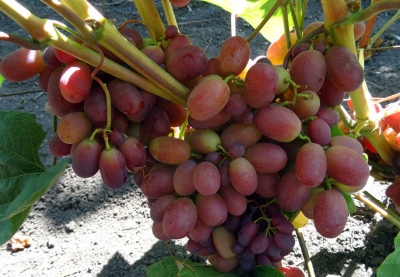
- Authors: "Vierul", Moldova
- Appointment: dining room
- Berry color: dark pink or dark red
- Taste: harmonious
- With bones: Yes
- Ripening period: early
- Ripening period, days: 120-125
- Frost resistance, ° C: -21
- Name synonyms: Glory to Moldova, Early Rizamat, Kizyl Uzum Kanibadam
- Bunch weight, g: 700-1000, some up to 2000
Shahinya of Iran is one of the most mysterious grape varieties. The main advantage of the grape variety is its beautiful appearance. All the gazebos, walls, fences entwined with vines, with beautifully hanging pink clusters, are an impressive sight.
Breeding history
It is not known who bred the variety, who its "parents" are. Many experts attribute it to the Moldovan selection, the Vierul Institute. According to another version, this grape came to Europe from Tajikistan. This is evidenced by another name - Kizyl Uzum Kanibadam. There are several more synonyms, these are names such as Glory to Moldavia, Early Rizamat.
Description
The vine in question has a very high growth rate. It blooms with bisexual flowers. The shade of the shoots is brownish, but the nodes have a red tone. The color of the leaves is dark green, the leaves are rounded, cut.
Ripening period
Shahinya of Iran belongs to crops of early ripening period. Full ripening of the fruit can be expected at 120 or 125 days. For example, in the gardens of Novocherkassk, the culture will ripen around August 15-20. The average harvest date is August 18th.
Bunches
The bunches of the variety have an attractive presentation, they are cylindrical-conical. Their size is large, they can weigh from 700 to 1000 g, some specimens reach 2 kg in weight. The brushes are of medium density, even slightly loose. In rainy summer, they are exposed to peas.
Berries
The fruits of Shahini Iran are elongated, have an average size of 36.2x22.1 mm, their color is dark pink or dark red. The grapes are considered very large, their average weight is 8-11 g. The pulp is fleshy.
Taste
The taste of the grapes is quite harmonious. Sugar content is at the level of 150-180 g / dm³, acidity is not so much - only 5-6 g / dm³.
Yield
The Shahinya table grape of Iran is considered a high-yielding crop with high levels of marketability and transportability.


Growing features
The Shahinya grape of Iran is a demanding variety. The plant loves watering and fertilizing with fertilizers. The vine must be pruned. If it rains in the summer for a long time, the berries may crack.
Landing
It is a thermophilic variety that likes plenty of sun rays. Shahinya of Iran does not tolerate windy weather, it is not recommended to plant a crop in low-lying areas, where cold air will stagnate.
You should choose a soil rich in nutrients, for example, black soil. If there is none, it is worth fertilizing any other with organic and mineral compounds.Grapes can be planted both in spring, before bud break, in April, and in autumn, it is better to do this in October.

Pollination
The flower type in grapes is bisexual. Therefore, additional measures for pollination are not required.
Pruning
To obtain a good harvest, the variety needs standardization. To do this, pruning the vine is done, leaving 8-12 eyes on each, 40-45 should be left on the bush.



Frost resistance and the need for shelter
The variety can tolerate not very severe frosts, the maximum indicators reach -21 ° C. The vine, of course, must be covered during the winter cold.

Diseases and pests
Shahinu Iran is distinguished by instability to fungal diseases. With regard to such ailments as mildew, as well as powdery mildew, susceptibility is rated at 4 points. It is necessary to treat grapes from diseases and pest attacks with appropriate preparations.

If a grape is exposed to any disease or insect, this always affects its appearance.
Storage
The variety is characterized by excellent keeping quality. If the room is cool, the bunches can last from 7 to 10 days.











































































